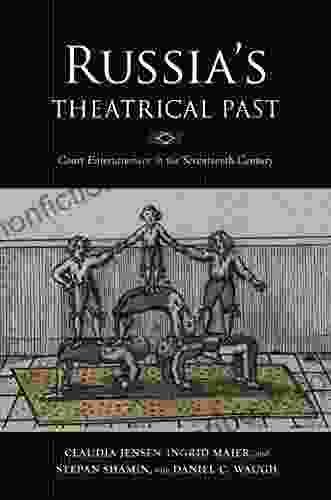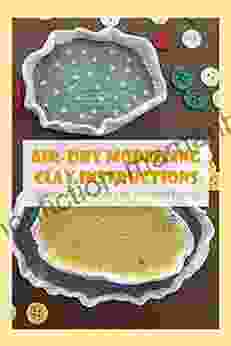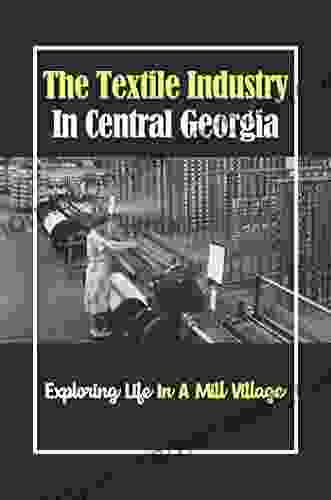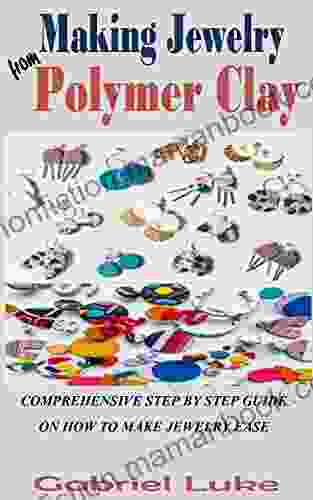The Ultimate Guide to Crafting Clay Recipes at Home: A Comprehensive Exploration of Materials, Techniques, and Troubleshooting

5 out of 5
| Language | : | English |
| File size | : | 17985 KB |
| Text-to-Speech | : | Enabled |
| Screen Reader | : | Supported |
| Enhanced typesetting | : | Enabled |
| Print length | : | 49 pages |
| Lending | : | Enabled |
Crafting your own clay at home is a rewarding and versatile activity that allows you to create unique and personalized pieces. Whether you're a seasoned potter or a beginner looking to explore a new hobby, this comprehensive guide will provide you with everything you need to know about crafting clay recipes at home.
We'll cover different clay types, ingredient choices, mixing techniques, and shaping methods, providing detailed tips and troubleshooting suggestions along the way. So grab your apron and let's get started!
Types of Clay
There are many different types of clay, each with its own unique properties and uses. Some of the most common types of clay include:
- Earthenware clay: A low-fire clay that is typically fired at temperatures between 900-1100 degrees Celsius (1650-2000 degrees Fahrenheit). It is porous and absorbs water, making it suitable for making pots, planters, and other objects that will not be exposed to moisture.
- Stoneware clay: A mid-fire clay that is typically fired at temperatures between 1100-1300 degrees Celsius (2000-2400 degrees Fahrenheit). It is denser and less porous than earthenware clay, making it suitable for making dinnerware, tiles, and other objects that need to be durable and waterproof.
- Porcelain clay: A high-fire clay that is typically fired at temperatures between 1300-1500 degrees Celsius (2400-2700 degrees Fahrenheit). It is the most dense and non-porous type of clay, making it suitable for making fine china, figurines, and other objects that require a high level of detail.
When choosing a clay type for your project, it's important to consider the firing temperature you have available and the desired properties of the finished object.
Clay Ingredients
In addition to clay, there are a number of other ingredients that can be added to clay recipes to modify their properties. Some of the most common clay ingredients include:
- Grog: Grog is a crushed fired clay material that can be added to clay to increase its texture and strength.
- Sand: Sand can be added to clay to reduce its plasticity and make it easier to work with.
- Ash: Ash can be added to clay to give it a unique color and texture.
- Additives: There are a number of commercial additives available that can be added to clay to improve its workability, strength, and durability.
The choice of clay ingredients will depend on the desired properties of the finished object.
Mixing Clay
Once you have chosen your clay type and ingredients, it's time to mix the clay. The best way to mix clay is to use a pug mill or a large bowl and your hands. A pug mill is a machine that mixes and kneads clay, but it can be expensive. If you don't have a pug mill, you can mix clay by hand. To mix clay by hand, add the dry clay ingredients to a bowl and gradually add water while mixing until the clay reaches a workable consistency. The clay should be moist but not too wet.
It's important to knead the clay thoroughly to remove any air pockets. Air pockets can cause the clay to explode during firing.
Shaping Clay
Once the clay is mixed, it's time to shape it into the desired object. There are a number of different ways to shape clay, including:
- Hand building: Hand building involves using your hands to shape the clay. This can be done by pinching, coiling, or sculpting.
- Wheel throwing: Wheel throwing involves using a pottery wheel to shape the clay. This is a more advanced technique that requires practice.
- Molding: Molding involves using a mold to shape the clay. This is a good way to create objects with consistent shapes.
The choice of shaping method will depend on the desired object and your skill level.
Drying and Firing Clay
Once the clay has been shaped, it needs to be dried and fired. Drying the clay slowly is important to prevent it from cracking. The clay can be dried in a warm, dry place or in a kiln. Once the clay is dry, it can be fired in a kiln. Kilns are heated to high temperatures to harden the clay and make it durable.
It's important to follow the firing instructions for your particular clay type. Firing the clay at too low a temperature can cause it to be weak and porous, while firing it at too high a temperature can cause it to melt or deform.
Troubleshooting
If you encounter problems while crafting clay recipes at home, there are a few things you can do to troubleshoot:
- The clay is too dry: If the clay is too dry, it can be difficult to work with and may crack. Add a small amount of water to the clay and knead it until it reaches a workable consistency.
- The clay is too wet: If the clay is too wet, it may be difficult to shape and may slump or collapse. Add a small amount of dry clay to the clay and knead it until it reaches a workable consistency.
- The clay is cracking: If the clay is cracking, it may have been dried too quickly or fired at too low a temperature. Try drying the clay more slowly or firing it at a higher temperature.
- The clay is too porous: If the clay is too porous, it may absorb water and become weak. Add a small amount of grog or sand to the clay to reduce its porosity.
If you continue to have problems, you can consult with a professional potter or ceramicist for assistance.
Crafting clay recipes at home is a rewarding and versatile activity that can be enjoyed by people of all ages and skill levels. With a little practice, you can create beautiful and unique objects that will be cherished for years to come. So grab your apron, experiment with different clay types and ingredients, and let your creativity flow!
5 out of 5
| Language | : | English |
| File size | : | 17985 KB |
| Text-to-Speech | : | Enabled |
| Screen Reader | : | Supported |
| Enhanced typesetting | : | Enabled |
| Print length | : | 49 pages |
| Lending | : | Enabled |
Do you want to contribute by writing guest posts on this blog?
Please contact us and send us a resume of previous articles that you have written.
 Top Book
Top Book Novel
Novel Fiction
Fiction Nonfiction
Nonfiction Literature
Literature Paperback
Paperback Hardcover
Hardcover E-book
E-book Audiobook
Audiobook Bestseller
Bestseller Classic
Classic Mystery
Mystery Thriller
Thriller Romance
Romance Fantasy
Fantasy Science Fiction
Science Fiction Biography
Biography Memoir
Memoir Autobiography
Autobiography Poetry
Poetry Drama
Drama Historical Fiction
Historical Fiction Self-help
Self-help Young Adult
Young Adult Childrens Books
Childrens Books Graphic Novel
Graphic Novel Anthology
Anthology Series
Series Encyclopedia
Encyclopedia Reference
Reference Guidebook
Guidebook Textbook
Textbook Workbook
Workbook Journal
Journal Diary
Diary Manuscript
Manuscript Folio
Folio Pulp Fiction
Pulp Fiction Short Stories
Short Stories Fairy Tales
Fairy Tales Fables
Fables Mythology
Mythology Philosophy
Philosophy Religion
Religion Spirituality
Spirituality Essays
Essays Critique
Critique Commentary
Commentary Glossary
Glossary Bibliography
Bibliography Index
Index Table of Contents
Table of Contents Preface
Preface Introduction
Introduction Foreword
Foreword Afterword
Afterword Appendices
Appendices Annotations
Annotations Footnotes
Footnotes Epilogue
Epilogue Prologue
Prologue Steven Becker
Steven Becker Michael Collins
Michael Collins William Tobin
William Tobin Brennan Barnard
Brennan Barnard Sarah Bower
Sarah Bower Claire Pearcy
Claire Pearcy Nico Tortorella
Nico Tortorella Lilian Harry
Lilian Harry Prabhat Mishra
Prabhat Mishra Julianne Bosch
Julianne Bosch Jennifer Chang
Jennifer Chang C B Hanley
C B Hanley William A Allen
William A Allen Robert Hendry
Robert Hendry Bobby Adair
Bobby Adair Clint Hill
Clint Hill Z L Arkadie
Z L Arkadie Jade Royal
Jade Royal Yuri Matsko
Yuri Matsko Emily Josephine
Emily Josephine
Light bulbAdvertise smarter! Our strategic ad space ensures maximum exposure. Reserve your spot today!

 Jarrett BlairEnglish Language Education for Students with Limited or Interrupted Formal...
Jarrett BlairEnglish Language Education for Students with Limited or Interrupted Formal... Felipe BlairFollow ·9.8k
Felipe BlairFollow ·9.8k Neil GaimanFollow ·11.1k
Neil GaimanFollow ·11.1k Preston SimmonsFollow ·18.5k
Preston SimmonsFollow ·18.5k Garrett BellFollow ·18.4k
Garrett BellFollow ·18.4k Jett PowellFollow ·14.6k
Jett PowellFollow ·14.6k Walt WhitmanFollow ·19.5k
Walt WhitmanFollow ·19.5k John KeatsFollow ·11.8k
John KeatsFollow ·11.8k Greg CoxFollow ·7.8k
Greg CoxFollow ·7.8k

 Steve Carter
Steve CarterUnveiling the Rich Theatrical Tapestry of Russia: A...
Origins and Early...

 Frank Butler
Frank ButlerOn Talking Terms With Dogs: Calming Signals and the...
For centuries, dogs have...

 Leo Tolstoy
Leo TolstoyThe Inside Guide to Applying and Succeeding in...
Applying to...

 Cole Powell
Cole PowellThe Political Economy of Global Finance, Farming and...
The global...
5 out of 5
| Language | : | English |
| File size | : | 17985 KB |
| Text-to-Speech | : | Enabled |
| Screen Reader | : | Supported |
| Enhanced typesetting | : | Enabled |
| Print length | : | 49 pages |
| Lending | : | Enabled |













